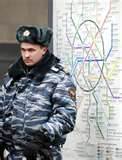Timeline[]
1979-1981[]
The Soviet Union invades Afghanistan. By the end of the Soviet-Afghan War, half of Afghanistan is held by the Soviet Union.
1983[]
Charlie Wilson dies of a drug overdose, and Operation Cyclone dies with him. The Mujahideen have little U.S. support and are quickly overtaken by Soviet forces. Afghanistan is entirely occupied and annexed by the Soviet Union in October. Premier Artyom Chzov, the first Soviet official born after the civil war takes over. Drawing on Stalin's strategies during the Second World War, Chzov imposes massive agricultural and industrial reforms. The cold war between the US and the Soviet Union seems to be drawing to a close.
1984[]
President Ronald Reagan holds talks with Soviet Premier Chzov. Reagan attempts to work out trade agreements and possible disarmament, but Chzov is determined to keep Soviet nuclear dominance.
1987[]
In East Berlin Premier Chzov calls for US president Ronald Reagan to "Tear down this wall!" giving a challenge to the US to destroy the Berlin wall and peacefully unite the two countries under one "free" communist rule.
1988[]
Protests in West Germany result in a brief civil war, Chzov sends covert agents to agitate a communist revolution, but the democratic.
1989[]
Increases in rioting and a deep recession call for emergency meetings in Washington. The U.S. takes out massive loans with the Soviet Union. The U.S. admits defeat in the Cold War against the Soviet Union. Weapon stocks and silos become the responsibility of the states in which they are located.
Protests in East Germany result in the reunification of Germany under the GDR and the dominance of communism in the country.
1991[]
The chaos is at its height in the U.S. President George H. W. Bush calls for emergency powers to meet in D.C. as Multiple states secede and the U.S. descends into anarchy.
1992[]
With the United States entirely dissolved into several nations spanning from the Mississippi river to the Pacific, Washington D.C. is able to convince most northern and and Midwestern states east of the Mississippi to form the New Washington Coalition.
1993[]
Alaska becomes the Alaska Republic. They build an economy based on fishing and oil. Chzov sees Alaska as fine addition to the Soviet Union, and moves naval forces into the northern Pacific.
1995[]
- California moves military into the Baja California peninsula. California has skyrocketing deficit and no real industries as of yet. California becomes a popular vacation destination for Soviet citizens, but this does not improve the economy despite the volume of tourists entering the country.
- A group of deep Southern states forms the Southern Confederacy.
1999[]
Chzov dies in a car wreck and is succeeded by his right hand man, Sasha Chernov. Chernov pursues Chzov's economic policies, but attempts to re-create the cordial American-Soviet affairs of the cold war.
The president of Washington and Premier Chernov meet in Munich to discuss nuclear disarmament. The Munich Compromise calls for the NWC to disarm 10% of its nuclear stockpile, while the Soviet Union will disarm 8% and end naval threats in Alaska. This landmark agreement marks an end of Chzov aggression. The Soviet Union remains the dominant nuclear power, but the NWC still has the most powerful navy in the world.
California creates collective marijuana farms and the nations economy improves. The California president meets with Premier Chernov to discuss further nuclear disarmament
2000[]
The deep South remains in a state of anarchy, primarily between communist, socialist, white supremacist, and other radical factions. Florida is the main battleground of these groups, but the fighting spreads to Alabama and other Southern states.
2001[]

A Soviet soldier stands guard in front of a metro station after the 10/25 attacks
October 25th terrorist from Afghanistan attack the Ostankino tower, Moscow International Business Centre, and Saint Basil's Cathedral. 200,000 civilians are killed during the October Revolution celebrations. Chernov sends Spetsnaz and KGB forces into Afghanistan, were several pocket remnants of former rebels are believed to be responsible.
2003[]
Chernov sends Spetznaz and KGB forces into southern Afghanistan to capture Al-Kabhak leaders responsible for the 10/25 terrorist attacks.
2004[]
Utah shoots down a Californian military helicopter. When asked for their reason, President Willard Mitt Romney of Utah claims "I was simply trying to protect my nation from a threat". A few months later a recording is found from which Pres. Romney accuses California as being "a godless socialist nation". California declares war and invades Utah.
2006[]
Alaska begins military buildup.
California and Utah come to an uneasy agreement ending the First Utah War.
2007[]
Arizona, California, and Colorado, declare war on Utah after revealing knowledge of unrestricted nuclear missile tests. The Second Utah War begins.
Ron Paul is elected president of Texas.
Republican Eli Collins is elected president of the New Washington Coalition.
2008[]
The Second Utah War ends. Utah agrees to disarm their nuclear weapons.
Sarah Palin is elected Alaska Republic president.
The USA invades Georgia, setting off the West Florida War, the decision is controversial worldwide, and leads to the independence of West Florida in the southern area, and the creation of Appalachia in the northern area.
2010[]
Palin's administration is found corrupt by the Alaska Supreme Court. Palin's cabinet is impeached on account of taking bribe money from several of Alaska's top oil companies. The Court decides to heavily fine these companies, sending them into bankruptcy. Palin's popularity plummets.
